It’s easy to get in a rut buying bags of “spring mix” greens, which mostly include mild, traditional lettuces and spinach. Next time you’re shopping, consider selecting some of the lesser-known spring greens like watercress, dandelion greens, mustard greens, and arugula; they are bursting with peppery flavor and are very versatile when cooking. They can zest up your salads, add deep flavor and nutrients to sautés, and they’re amazing sprinkled on top of cooked dishes. Eating them is like a spring cleaning for your body — they’re deeply nourishing, their fiber helps your body shed waste, and their nutrients both detoxify and give your immune system a healthy boost. Below, you’ll find easy ways to treat yourself to their fresh spring goodness.
| ARTICLE SHORTCUTS:
LEARN MORE ABOUT: |
RECIPE SHORTCUTS: |
Shopping & Storage Tips
- For optimum nutrition, buy greens in season. Look for bright-green leaves that are firm with no signs of wilting.
- Choose organic, local greens when possible. Greens grown in well-managed soils provide maximum flavor and nutrition.
- Always eat greens as soon as possible after they’ve been picked. Avoid washing greens before storage, as they’ll spoil more quickly. You can store unwashed greens wrapped in a damp paper towel inside a slightly open plastic bag for up to a few days in your crisper drawer.
Nutritional Know-How
- High in fiber, greens help your body shed waste, minimize your absorption of DNA-damaging toxins, lower cholesterol, and slow the rise of blood sugar after a meal.
- Phytochemicals in spring greens — especially arugula — stimulate circulation, fortify the liver, and provide mild diuretic and laxative properties, making them great detoxifiers.
- Powerful antioxidants like lutein, beta-carotene, and zeaxanthin help your body resist DNA damage from free radicals, reduce the risk of macular degeneration, calm inflammation, and prevent certain cancers.
- Antioxidants like vitamins C and E in spring greens provide powerful immune support.
- The vitamin K in spring greens — especially dandelion greens, which have 535 times the daily recommended amount — strengthens bones and limits neuron damage in the brain, which may help prevent Alzheimer’s disease.
Kitchen Tricks
- Just before use, wash greens in a sink full of cold water to clean them and liven them up, then spin dry.
- If the stems are tougher than the leaves, try separating them before cooking. Put the stems over heat first, adding greens at the last minute.
What Are Spring Greens?
Mustard Greens
The distinctly pungent flavor, wide array of textures, and beautiful color — whether emerald green, dark red, or deep purple — of mustard greens make this cruciferous vegetable a beautiful, tasty addition to meals.
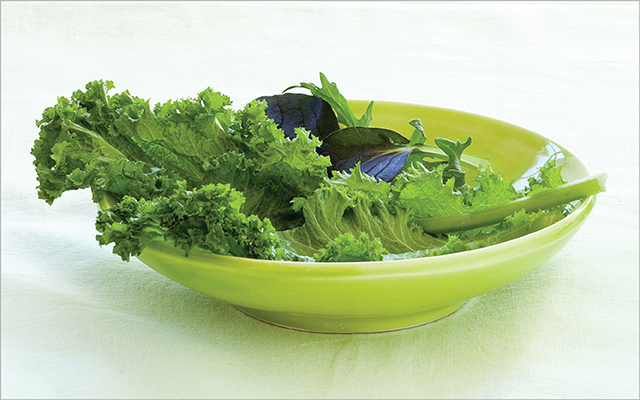
- Mustard greens originated in the Himalayas and today are an important ingredient in Southern cooking.
- To tame the bitterness, use heat (sauté or blanch), salt (tamari, bacon, or prosciutto also work well), and oil (like extra-virgin olive oil, sesame oil, or nut oils).
- For a simple dish, enjoy mustard greens sautéed with walnuts. You can also add young or finely chopped raw mustard greens to salads for a kick.
Arugula
With a crisp texture and a sweet, spicy, bitter flavor, arugula is one of the most peppery spring greens.

- A relative of broccoli and cabbage, arugula is a cruciferous veggie that’s terrific raw in pesto and salads — it’s a main ingredient in salad mixes called mesclun — or as an unexpected topper on pizza or eggs.
- It’s less pungent when added to hot foods like pasta or cooked vegetables, or used like an herb in sautés.
- Learn more about arugula by seeing “How to Buy and Store Arugula“.
Dandelion Greens
These natural healers help support strong bones and healthy skin and ward off cancer.
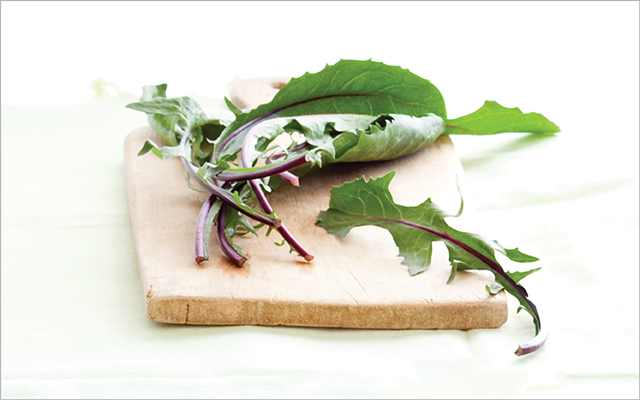
- When they grow, they usually pop up on degraded land, where their roots pull nutrients from deep in the soil back up to the surface through their leaves. You can harvest these greens just about anywhere they haven’t been exposed to chemicals.
- Their earthy, nutty, bitter flavors are best right after picking, and before the plants’ yellow flowers emerge.
- To reduce bitterness, especially with older leaves, try steaming them before sautéing, or blanch them, saving the water as dandelion tea. Or combine dandelion greens with a mix of sweet, sour, or salty foods to balance the bitterness on your palate.
- They’re especially good raw in salads or blended into smoothies, or braised with garlic, meat, or vinegar.
- And don’t forget the dandelion’s roots, which are sweet and can be cooked like parsnips.
- Learn even more about why these greens deserves a place on your plate at “Dandelion Greens“.
Watercress
Delicate and crisp, this water-grown delight is one of the earliest-known leafy greens eaten by humans.
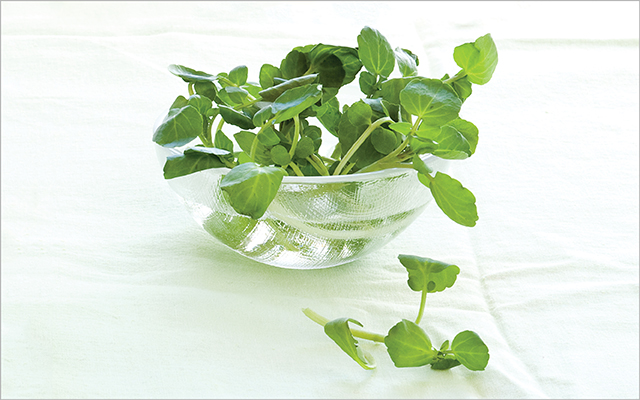
- Related to radishes and mustard, watercress has a strong peppery flavor that pairs well with similarly assertive flavors like salty meats and olives, or contrasts with milder flavors like goat cheese, pears, or walnuts.
- It’s great raw on salads and in sandwiches, but avoid exposing it to prolonged high heat.
- Because watercress wilts easily, add it to soups and pastas at the last minute, or toss it fresh onto already cooked hot foods.
Spring Greens Recipes
Spring Greens and Zucchini Lasagna
This grain-free lasagna has thinly sliced zucchini instead of pasta — eggplant makes a great substitute, too — and it’s served with a roasted-carrot sauce. Adding a little nutritional yeast and almond flour to the ricotta provides richness and flavor.

Makes six servings | Prep time 20 minutes | Cooking time 75 minutes
Ingredients
- 3 large, whole carrots, washed and trimmed
- Extra-virgin olive oil
- 3 to 4 medium zucchini, cut lengthwise into 1/4-inch slices
- Salt and freshly ground black pepper
- 3 cups chopped arugula, watercress, dandelion greens, or mustard greens
- 11/2 cups ricotta cheese
- 1 clove garlic, pressed
- 2 eggs, beaten
- Zest of 1 lemon
- 2 cups vegetable stock
- 1 tbs. chopped fresh dill
- 1/4 cup shredded Parmesan cheese
Directions
- Preheat oven to 375 degrees F.
- When oven is hot, place the carrots on a lightly oiled baking sheet. Roast until they are tender, about 25 minutes.
- Meanwhile, prepare the lasagna ingredients. Roast the zucchini slices on a lightly oiled sheet until just tender, about 10 minutes. Season the zucchini with salt and pepper. Remove the roasted zucchini from the sheet, replace with the arugula, and return the pan to the oven to wilt the greens, about five to seven minutes.
- Mix the ricotta cheese with the garlic, eggs, and lemon zest, and season with salt and pepper.
- When the carrots are roasted, add to a blender with the vegetable stock and blend until smooth. Season with chopped fresh dill, salt, and pepper.
- Reduce oven temperature to 350 degrees F. Pour half of the carrot-dill sauce in the bottom of a 9-by-9-inch pan.
- Line the bottom of the pan with a single layer of the zucchini slices, then cover with half of the roasted greens. Top with the ricotta-cheese mixture, sprinkle with the remaining greens, and layer with the zucchini slices. Pour the rest of the carrot sauce on top and sprinkle with the Parmesan cheese.
- Bake for 30 to 35 minutes, and serve.
Watercress, Citrus, and Avocado Salad
Change up this classic salad by trying other combinations: dandelion greens with a balsamic and dried-cherry vinaigrette, or arugula with a warm pancetta dressing and shaved Parmesan. For a heartier salad, add diced smoked turkey or chicken, or a crumble of cooked bacon.
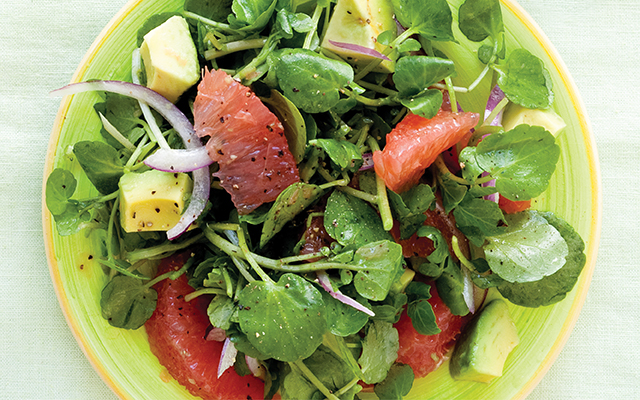
Makes four servings | Prep time 10 minutes
Ingredients
- 4 cups coarsely chopped watercress, stems included
- 1 cup pink grapefruit segments, juice reserved
- 11/2 cups diced avocado (about 1 avocado)
- 1/4 cup finely sliced red onion
- 1 tbs. white-wine vinegar
- 4 tbs. walnut oil
- Salt and freshly ground black pepper
Directions
- Toss the greens together with the grapefruit, avocado, and onion.
- Whisk the reserved grapefruit juice, vinegar, and oil together, and season to taste with salt and pepper.
- Pour over the salad.
Spring Greens Korean Rice Bowl
Greens are an essential part of any rice-bowl dish. This version features pork, but you could easily use beef, chicken, fish, or tempeh, and you can sub in any seasonal veggies.

Makes four servings | Prep time 45 minutes, plus marinating time | Cooking time 15 minutes
Ingredients
- 2 tbs. tamari
- 1 tsp. toasted sesame oil
- 1 tbs. grated gingerroot
- 2 garlic cloves, sliced
- 1 tbs. honey
- 3/4 pound pork loin, sliced into 1/8-inch-thin strips
- 1 cup julienned cucumber
- 1 tsp. brown-rice vinegar
- 1 tbs. peanut oil
- 5 green onions, chopped
- 6 cups chopped mustard greens, dandelion greens, or watercress
- 4 cups cooked brown rice
- 6 radishes, thinly sliced
- 1 cup julienned carrot
- 4 tsp. toasted sesame seeds
- Kimchi for serving (optional)
- 4 poached eggs (optional)
Directions
- Combine the tamari, sesame oil, ginger, garlic, and honey with the pork strips in a bowl; marinate the meat for at least one hour or overnight.
- Drizzle the cucumber with the brown-rice vinegar.
- Heat a heavy skillet with the peanut oil, and sauté the meat and its marinade with the green onions. When the meat is cooked, toss in the greens and cook until wilted.
- Divide the cooked rice into individual bowls, and top with the meat and greens, radishes, carrots, and cucumbers, and sprinkle with the sesame seeds.
- Serve with kimchi and top with a poached egg, if desired.
Spring Green Pakoras: Indian Fritter
These little Indian fritters are traditionally made with spinach or other vegetables but are fantastic when made with mustard greens, dandelion greens, watercress, nettles, or arugula. Serve with the yogurt-mint sauce.

Makes 12 | Prep time:10 minutes | Cooking time 10 minutes
Ingredients
- 1 cup garbanzo-bean flour
- 1 cup plain full-fat yogurt, divided
- 1/4 cup cold water
- 1 cup chopped mustard greens or other spring greens
- 4 green onions, sliced
- 1 tsp. whole cumin seeds
- 1 tsp. ground coriander
- Salt to taste
- 2 cups peanut oil
- 1 tbs. minced fresh mint leaves
- Dash of cayenne pepper (optional)
Directions
- Mix the garbanzo-bean flour, 1/2 cup of yogurt, and water in a bowl until smooth. Stir in the greens, onions, cumin seeds, coriander, and salt until well combined to make the pakora batter.
- Heat the oil in a heavy saucepan to 350 degrees F.
- Meanwhile, make the yogurt sauce by mixing the remaining yogurt with mint and salt to taste. Add a dash of cayenne pepper if you want to spice it up.
- Drop 1 tablespoon of the pakora batter into the hot oil. Continue until you have three to four pakoras in the oil. Fry until they float to the top, about three to four minutes. Continue with the remainder of the batter.
- Drain on a cooling rack, sprinkle with a little salt, and serve with the yogurt dipping sauce.
Spring Greens Tonic
Make a refreshing cleansing juice with celery, lemon, romaine lettuce, and watercress or another spring green. Add a green apple or a pear for sweetness if you like.
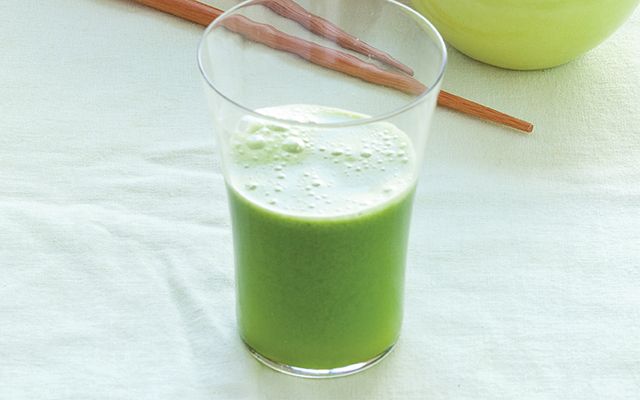
Makes 24 ounces | Prep time three minutes
Ingredients
- 5 stalks celery
- 1 head romaine lettuce
- 1 bunch watercress or arugula
- 1/2 cup fresh mint leaves
- 1 lemon
- 1 Granny Smith apple
Directions
- Run all ingredients through a juicer and enjoy immediately.
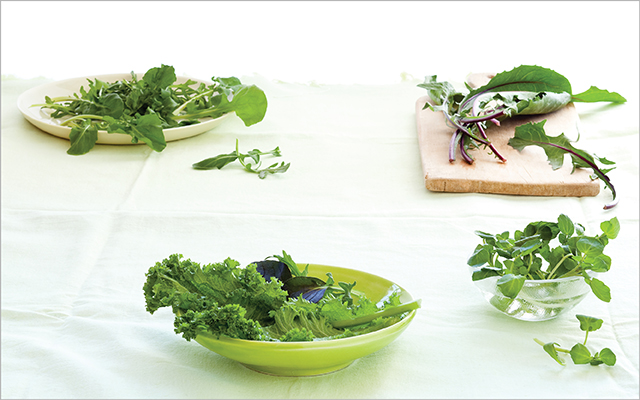

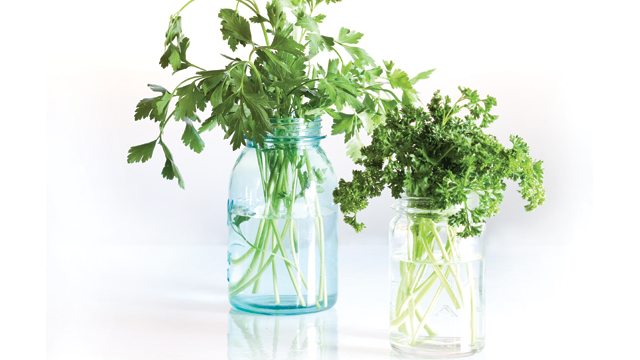
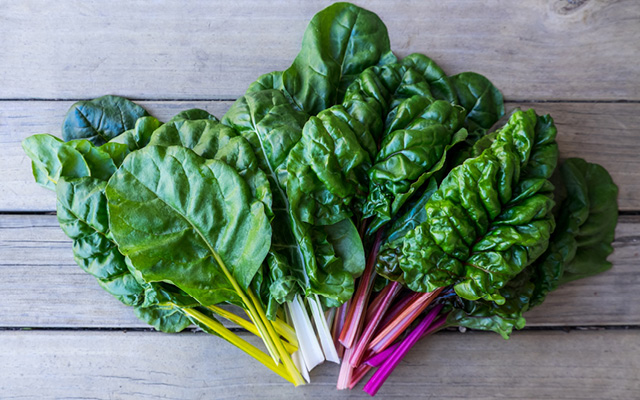
This Post Has 0 Comments